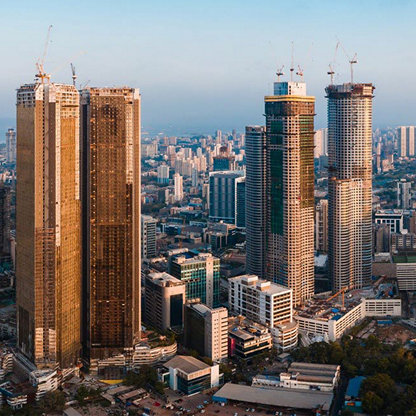What specific investment challenges are neighbourhood decarbonisation initiatives in parts of Africa, India and Southeast Asia encountering, and how are these being overcome? A recent webinar welcomed experts to discuss these issues.
Decarbonisation initiatives must be inclusive of local, rural and dispersed communities
‘The most pressing challenge lies in bringing decarbonisation and net zero down market … how to include SMEs and distributed markets (residential, agriculture, forestry, and fisheries) in decarbonisation initiatives’ says Alexander Ablaza, CEO, Climargy, and Co-chair, Asia-Pacific ESCO Industry Alliance. Dr Timothy Afful-Koomson, Regional Director, GFANZ, Africa, agrees. ‘Whether promoting high efficiency low-cost LED lighting, improving building automation systems, having a high efficiency AVAC, integrating sanitation or waste management into energy systems, where the rubber hits the road is usually local or municipal.’
‘The challenge I tackle on a day-to-day basis is how to scale up suitable technologies, and in the process, bring in climate finance’, says Sandeep Bhattacharya, Climate Change Advisor, GIZ India. Whereas solar and wind have been supported by governments for decades and have now become competitive, there are more technologies that need to be scaled up, like batteries that can support a net zero grid.
Alongside urbanisation, rural development brings decarbonisation challenges and opportunities
Rapid urbanisation is a boon and bane to decarbonisation, explains Alex. The economic development associated with urbanisation would bring in more innovative financing modalities and more mature financial markets. Alongside this, you get incremental loads on energy systems as lifestyles change and, for example, families get their first AC. Quality of life lower improves, but energy intensity does as well, he says.
Around 3.3 GW more energy generation and transmission capacities are needed in May (the hottest month) compared to January (the coolest) in the Philippines, explains Alex. ‘With increasing urbanisation, the peak demand curve is getting steeper and steeper. The correlation between GW capacity and rise in heat index is clear. There are two ways to flatten the curve: with energy efficiency measures, or with load shifting’, he says. The IEA estimates annual investment in energy efficiency will need to triple - to about USD 1.9 trillion in 2030 - to reach energy and climate goals. Alex continues, ‘Innovative financial structures could help close this gap, and products such as Energy Services Company (ESCO) performance contracts, joint venture agreements and PPPs, where equity, rather than debt finance is engaged.’
‘We shouldn’t lose focus on some of the new and emerging consumption patterns that are also happening in rural areas’, says Timothy. Another dimension in Africa is remittances coming from abroad. Someone who isn’t living in Accra, Dar es Salam or Lagos, for example, but in a rural area, can now afford a refrigerator or diesel generator due to these remittances, he says.
Urbanisation has not happened in a planned manner in India. However, there are green shoots for decentralised growth. This is in the form of distributed renewable energy applications in rural locations, states Sandeep. A solar panel can run a pump, a grain grinder or other agricultural and household appliances. ‘I am hopeful that green livelihoods can simultaneously be created in remote areas, largely due to distributed and renewable energy’, he says.
Risk perception and scale and project complexity among the biggest barriers to investment
‘Africa needs roughly USD 270 billion each year for net zero decarbonisation. Currently, total climate finance is about USD 30 billion per year, so that’s a 240 billion financing shortfall’ states Timothy. When it comes to local/municipal level financing, the first barrier to overcome is risk perception. A company in Africa could be dealing with as much as 500 basis points more on the cost of capital than a company with a similar financial profile located in Asia Pacific or Latin America. A project could be very financially viable, he says, but because of location, it becomes untenable. He concludes, credit ratings should be based on actual rather than perceived risk.
A second problem that Timothy explains is scale. Local projects and initiatives are often too small in scale to attract investment, he says. ‘Most of the projects GFANZ have found at the municipal level are looking for USD 1 million dollars, whereas banks like HSBC have minimum requirements that are between USD 5 and 10 million dollars.’
Initiatives that aggregate projects are achieving the scale necessary to attract financing
‘An initiative worked wonders with LEDs. Unnat Jyoti by Affordable LEDs for All (UJALA) is the world’s largest lighting replacement programme. Energy Efficiency Services Limited LED bulk procurement has contributed to the reduction in LED retail market prices from approximately 800 INR per LED bulb in 2012 to 200 INR per LED bulb in 2016 – leading to one of the fastest LED price reductions in the world’, explains Sandeep.
Alex explains aggregation is one of the best ways to attract investment in neighbourhood energy efficiency projects. ‘To borrow Timothy’s words’, he says, ‘an aggregation model is needed that can pool many USD sub-3 million dollar projects into a vehicle that would attract debt and equity. Many ESCOs in developed and developing Asia do not have suitable access to commercial lending or bank lending, so cannot pursue a real pipeline of performance contracts’, he says. To address this, Climargy has pooled several Energy Services Company (ESCO) projects into a portfolio, and invests equity capital in ESCO project assets outside the balance sheets of both the ESCO and the building or facility owner.
Steve Turner is Director of 3Ci (Cities Commission for Climate Investment) and Moderator for the webinar. He explains that city neighbourhoods in the UK also have a problem with scale. ‘A typical city municipality project is about USD 7 million, which is not big enough for a private investor’ he says. As a response, 3Ci asked 100 municipalities for their projects, and has created a national pipeline with a value of about USD 80 bn, which can be bundled either geographically or by typology for investors, who are responding well to that approach.
National policy frameworks must be structured to encourage investment in local decarbonisation initiatives
‘In the US, you can monetise DER (distributed energy resources) in the financial model because there is certainty in the revenue. You can look at different ownership, corporate and tax systems. New laws, regulations, incentives, rebate or grant programmes get introduced and could be integrated, not only at national level, but at local and state level’, says Timothy. Because this diversity of financial and policy mechanisms is not readily available in Africa, GFANZ are working with municipalities in the region to come up with incentives that could be integrated into financial models, explains Timothy. These could be in the form of tax rebates for financing solar energy on public assets such as hospitals.
In India, Sandeep advises, the government has created the right conditions for a long list of climate tech startups to develop. ‘One of my current projects is focused on improving resilience in agriculture. We are speaking to micro-finance institutions to see if they can include these new technologies in their product portfolios. It’s an appropriate action at the appropriate place. It’s not the government’s role to encourage small scale loans for these solutions, but if they hadn’t created the right environment for these startups, we couldn’t then take the next steps at the local level.’
In India, the government has created the right conditions for a long list of climate tech startups to develop. ‘One of the Indo-German development cooperation projects that I currently work with is focused on improving climate resilience in agriculture. We are speaking to micro-finance institutions (MFI) to see if they can include these new technologies (for example, polymers which absorb water when it rains and releases it when the plant needs it, 0.3 HP portable woman-friendly solar pumps) in their product portfolios. It is an appropriate action at the appropriate place. It is not the government’s role to ask financial institutions to do the small-scale loans for these solutions. But, if they had not created the right environment for these startups, the start-ups would not exist and we could not take the next steps at the local level, says Sandeep.
‘Something that not even multi-laterals or governments are thinking much about, is the financing of forced obsolescence of low efficiency energy usage such as cooling and air conditioners’, says Alex. Similarly, there are many markets that have difficulty phasing out oil or gas energy subsidies. ‘This delays the shift of end users to renewables or more energy efficient technologies,’ he explains. He states, ‘to prime more private capital flows, government, regulators and development agencies will have to investigate why investors remain unable to get commercially viable equity returns.’
Disclaimer: This article reflects the personal opinions of the authors.
Note: This page contents was updated on 09/12/24.
In this World Built Environment Forum webinar, we explore the localised strategies currently being undertaken in cities and municipalities in India, the Philippines and Southeast Asia, and in Cote d’Ivoire and Africa. This panel of experts from across global regions also discusses the discuss the drivers and barriers to attracting finance for low carbon and energy efficiency measures at the neighbourhood scale.
* To access subtitles please select these from the youtube menu at the bottom of the video.
Related articles



